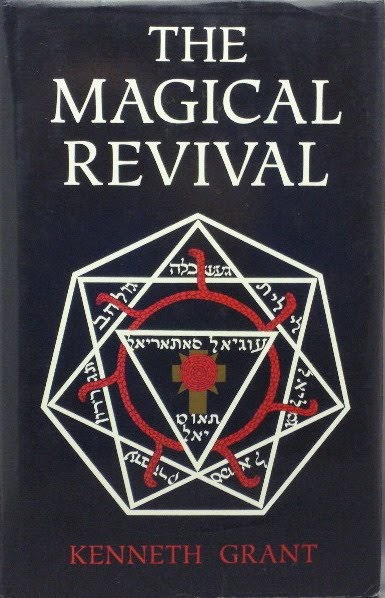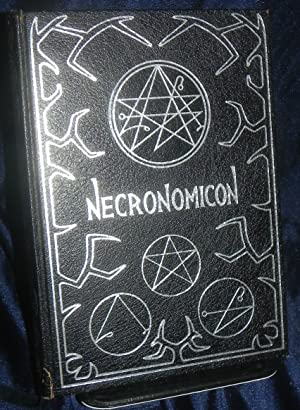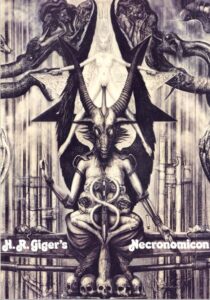Reflections: On Lovecraft, landscape and urban wonder
I was recently asked to write something about what were the main influences that shaped my short book on Cthulhu Mythos magic – The Pseudonomicon. Reflecting on this was difficult at first, as some of the ideas that went into it had been rattling around in my head since the early 1980s. My first experiments with Lovecraftian Magic were enacted in 1980 or thereabouts, so trying to think back to that time was a challenge, to say the least. At this time of my life, I was studying for a degree in the Behavioural Sciences – a joint honors degree that encompassed Psychology, Sociology, Social Policy, and Philosophy at what was then Huddersfield Polytechnic. I’d been interested in the occult for about three years at this point and was still dipping my toes into actual magical practice in any sustained or coherent way. Some of the ideas and suggestions for Cthulhu Mythos magic in The Pseudonomicon were shaped by my dissatisfaction with how Lovecraft’s themes had been treated by other occult authors. Yet at the same time, those authors had an influence on me, insofar as they at least opened the way to the connection between fictional horror and magical experience.
The thing that came up a lot – and still occasionally does, regarding the Cthulhu Mythos is that it is fiction, and therefore not a ‘proper’ source for magical work – unlike mythology or history. This distinction never really bothered me. When I started experimenting with Cthulhu Mythos themes I didn’t make much of a distinction between different genres of the occult. Spiritualism, Wicca, the writings of Aleister Crowley; the rituals of the Golden Dawn – I devoured any book I came across. It was all part of the exciting new world I had discovered. Lovecraft’s fiction was just another slice of the pie. This casual acceptance of the validity of fiction as a source of inspiration for magic was doubtless helped along by some of the books I’d been reading.
This reading was, for the most part, a solitary exercise. At the time I knew few other actually practicing occultists. There was an older guy in my year at the poly who’d briefly dabbled with ceremonial magic and had been in the Order of the Cubic Stone (OCS). His older sister Shirley was still involved with that group and seemed to have been a practitioner for some years. She actually had a letter from Kenneth Grant! But apart from Shirley, there was no one. I knew people who were ‘interested’ of course (and met more after I’d performed the Cthulhu Pathworking that is featured in The Pseudonomicon) but no one really with hands-on experience as it were. In 1980, I started a postal correspondence course with the OCS. They sent me exercises and simple rituals; I kept a diary, sent letters to my mentor, and he replied with appropriate feedback. I never mentioned my interest in Lovecraftian magic to my OCS mentor. His admonition for me spelling magic with a ‘k’ (“we are not Thelemites!!!” in red ink) and warnings about the “dangers” of messing with sigils (courtesy of an early edition of Ray Sherwin’s The Book of Results) tipped me off that he would probably not be sympathetic to the suggestion that I might want to contact Cthulhu. So whilst there was no one to advise me on what to do; there was no one to tell me not to do it either. Decades later, I came to see this very lack to be a positive thing as people would come onto occult forums such as Barbelith and have their sometimes wild ideas shot down by ‘experienced’ occultists telling them their schemes were foolish, dangerous, or simply unworkable.
First off then, Kenneth Grant. I’d first encountered Kenneth Grant’s writings in the bound copies of Man Myth and Magic in my school library and later found that my local library had a copy of Images & Oracles of Austin Osman Spare. By 1980 I’d certainly read The Magical Revival, first published by Frederick Muller in 1972. I found some of Grant’s views on Lovecraft and other writers of horror fiction intriguing but thought that his attempt to draw parallels between Lovecraft’s themes and Aleister Crowley to be a bit of a stretch, to say the least. Nor was I particularly taken with the notion that Lovecraft was unconsciously channeling occult influences or that he had failed to ‘cross the abyss’.
Then there were the Necronomicons. The late seventies had seen a variety of ‘Necronomicons’ published. There was the ‘Simon’ Necronomicon – published in a deluxe hardback edition with silver inlays in 1977. I briefly owned a copy. It certainly looked the part, but I was not convinced by the contents. Still, it was an influence of sorts, and although I no longer recall the exact details, in all likelihood I used some elements of it in my attempt to summon Yog-Sothoth on a mountaintop. All I can remember of that ritual is that a beam of light seemed to descend from the stars into the rocky outcrop where I stood, and then I was running pell-mell down the slopes of the mountain, my torch swinging crazily until I fetched up at a friend’s house on the edge of the village, out of breath and scared out of my wits. Had anything really happened? I doubt it. Rather, I had given myself a fright with the understandable combination of a nightly ritual on a lonely hilltop.
The second Necronomicon in my collection was H.R. Giger’s book of that title, first published in 1977. I’d ordered it just on the strength of the title, and having just watched Alien (1979) but was vaguely disappointed by the lack of ‘magical’ content. Still, of all the books entitled ‘Necronomicon’ that I read, it was Giger’s artwork that came closest to the notion that the Necronomicon was somehow ‘blasphemous’ and shocking. I purchased a poster of one of Giger’s artworks at a psychic fair in Leeds, and on my return to the house I then shared with two other students, and stuck the poster up over the television. I then disappeared on one of my semi-regular plunges through Huddersfield’s nightlife. Returning a few days later, the poster had been moved to the broom cupboard. Neither of my housemates could watch television without their eyes being drawn to the poster.
More intriguing was the Necronomicon: Book of Dead Names, published by Corgi in 1980. This collection included an essay by Angela Carter and contributions from Robert Turner. Turner was the head of the Order of the Cubic Stone. This at least gave Necronomicon: Book of Dead Names a degree of authenticity to me. It was some years before I discovered that the book was for the most part a spoof. What gave it away was the essay by David Langford – a sci-fi writer whose work I later encountered in White Dwarf – the Fantasy Roleplaying magazine published by Games Workshop. One of my OCS friends later said that Robert Turner regretted his contribution to the book, due to the amount of crank mail he’d received.
Again, I wasn’t really convinced by the ostensibly ‘occult’ parts of this book, but the essay by Angela Carter, Lovecraft and Landscape, I later came to realize, was influential in the way I came to regard the magical potential of Lovecraft’s imagery. At the time, I was living in a small village on the edge of the Pennine chain – a range of mountains sometimes known as ‘the backbone of England’. I took long, solitary walks up into those mountains, and it was during those walks that I began to see that as much as Lovecraft’s fiction features cosmic horror and incursions of beings from other dimensions, it also fostered a particular relationship with the landscape. In Lovecraft’s tales the landscape – be it daemon-haunted woods or the urban terror of Red Hook is as much an active presence as any degenerate cultist or lurking monster. Perhaps more so. Carter, in her insightful essay, highlights the ever-present sense of dread in Lovecraft’s depictions of landscape – they are “paranoid landscapes” where order gives way to hybridity; where well-planned streets and architecture suddenly become twisted labyrinths at the heart of which lies the unnameable. Just as I walked into the mountains, I also spent many hours wandering the streets of Huddersfield and its outlying townlets. Unlike Lovecraft though, I found, instead of dread and revulsion an appetite for surprise and perhaps a fleeting sense of wonder. I ducked into alleys and explored ginnels; I made my way through the sad remnants of abandoned mills and factories – mute testaments to a vanishing industrial past.
So many of the occult books I had read at that time seemed to be focused on transcendence of one kind or another – on contacting ‘higher planes’ or a union with a ‘higher’ or ‘spiritual’ selfhood. Lovecraft’s descriptions of brooding presences encountered in cities, green spaces, and lonely mountains afforded me a glimpse of how magic was present – and could be sensed – in the everyday world. Again too, few occult texts seemed to deal directly with the notion that just living in a city could be, in itself, magical. Some authors seemed rather, to be dwelling in the shadow of the 19th-century horror of urban living (see for example this post) whilst others seemed to assume that practitioners lived in houses large enough for them to have a separate room as a temple. Occult works seemed to vacillate between dwelling in comfortable, middle-class suburbia or a romanticized view of nature that, if it had ever existed, had long since vanished, and was, for the most part, confined to pathworking or guided meditations.
Despite a lack of guidance – at least from occult texts, I grew steadily fascinated by cities. When I moved to Leeds in 1986, I tried to cultivate the sense of the city as an entity of sorts. An entity whose moods could be read, faintly perhaps, in the patterns made by flights of starlings; in the faded graffiti on underpasses and street corners.
Reflecting now, I am sure that Lovecraft, for all his professed antiquarianism, would not have liked British cities. All the cities I have lived in – Lincoln, York, Nottingham, Leeds, and now, London, have that maze-like quality that so prominently features in what Angela Carter refers to as Lovecraft’s ‘landscapes of abandonment’. Only yesterday, on a Sunday walk down a street I’d passed along many times, I noticed a building set back from the road–perhaps an old chapel-that I had not noticed before, and immediately felt the desire to find a way to its rear, to discover the way through a labyrinth of alleys folded between the houses.
It’s perhaps ironic, that despite the sometimes emphasis in Lovecraftian fiction and magic on other dimensions, alien spaces, and ‘otherness’; its lasting legacy for me, has been an appreciation and wonderment at the world I move through, and the surprises that might open up around the next street corner.
With thanks to Aria deSatanas and Chris Jossife for their efforts in sending me copies of Angela Carter’s essay Lovecraft and Landscape.
The Pseudonomicon is available direct from Original Falcon Press as ebook or print edition.






One comment
Cat Vincent
Posted November 10th 2022 at 7:50 am | Permalink
My awakening to the possibility urban magic, the unheimlich entering the sort of environment I lived in, was early; via Alan Garner’s Elidor when I was 6 or 7.
But my first examplar that a working class dockrat like me could actually work urban magic, that the Wyrd didn’t just live in rurality, came from that nasty piece of work John Constantine.